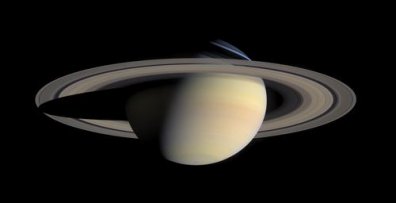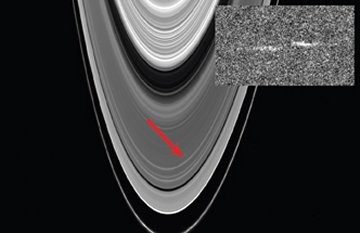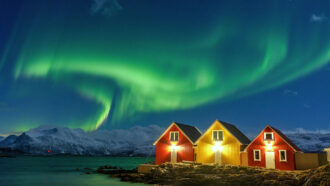Saturn’s rings created by collision
A shattered moon may have produced Saturn's dazzling rings.
By Emily Sohn
When kids learn about the planets, Saturn and its spectacular rings always stand out. And one of the first things that everyone wants to know is how Saturn got its rings.
 |
|
Saturn and its rings.
|
| NASA/JPL/Space Science Institute |
One theory is that an asteroid or comet hit one of Saturn’s icy moons about 100 million years ago. Upon impact, the moon broke into lots of pieces that spread out into rings.
The latest evidence for this theory comes from pictures taken by the Cassini spacecraft, which is currently orbiting Saturn. On July 1, 2004, Cassini flew through the planet’s rings on its way into orbit (see “Ringing Saturn“).
Looking closely at images taken that day, Cornell University researchers detected four gaps in the bright middle section of Saturn’s outermost main ring (called the A ring). The gaps are shaped like propellers, and they measure 5 kilometers (3.1 miles) wide.
 |
|
A propeller-shaped gap (white streaks in inset) in Saturn’s ring (arrow) supports the theory that the planet’s rings were created when a comet or an asteroid shattered a large Saturnian moon. A moonlet about 100 meters wide would have created the gap.
|
| NASA/JPL/Space Science Institute |
The scientists suspect that the gaps were created by fragments of the shattered moon—tiny moonlets about 100 meters (330 feet) across. The moonlets are probably still out there, but they’re too small for Cassini to see directly.
Scientists had previously detected water-ice chunks in the A ring that measure less than 20 meters (66 feet) across. They had also seen two larger moonlets: Pan, which is 30 kilometers (19 miles) wide, and Daphne, which is 7 kilometers (4 miles) wide.
Neither the icy chunks nor the large moonlets, however, can explain the size and shape of the gaps that show up in the Cassini snapshots. The existence of these gaps suggests the presence of fragments of an in-between size. Indeed, it makes sense that a shattered moon would produce moonlets of many sizes.
At the same time, the new evidence fails to support another leading theory about Saturn’s rings. This theory proposes that the rings formed out of the same gas, dust, and ice that produced the planets during the birth of our solar system. If that were true, however, moonlets would not have been able to get much bigger than about 10 meters (33 feet) across, thanks to Saturn’s gravity and collisions between chunks.
The Cornell researchers suspect that Saturn’s A ring contains some 10 million moonlets that measure about 100 meters wide.—E. Sohn
Going Deeper:
Cowen, R. 2006. Propelling evidence: Cassini finds clues to source of Saturn’s rings. Science News for Kids 169(April 1):198. Available at http://www.sciencenews.org/articles/20060401/fob7.asp .
For additional information about the Cassini mission to Saturn, go to http://saturn.jpl.nasa.gov/home/index.cfm (NASA).
Information about Saturn’s moonlets is available at http://saturn.jpl.nasa.gov/news/press-release-details.cfm?newsID=643 (NASA).
Sohn, Emily. 2004. Saturn’s new moons. Science News for Kids (Aug. 24). Available at http://www.sciencenewsforkids.org/articles/20040825/Note3.asp .
______. 2004. Ringing Saturn. 2004. Science News for Kids (July 28). Available at http://www.sciencenewsforkids.org/articles/20040728/Feature1.asp .







